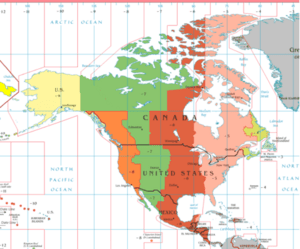Pacific Time Zone facts for kids
Quick facts for kids Pacific Time Zone |
|
|---|---|

Pacific Time Zone
|
|
| UTC offset | |
| PST | UTC−08:00 |
| PDT | UTC−07:00 |
| Current time | |
| 02:20, April 26, 2025 (PT) () | |
| Observance of DST | |
| DST is observed throughout this time zone. | |
The Pacific Time Zone (PT) is a time zone encompassing parts of western Canada, the western United States, and western Mexico. Places in this zone observe standard time by subtracting eight hours from Coordinated Universal Time (UTC−08:00). During daylight saving time, a time offset of UTC−07:00 is used.
In the United States and Canada, this time zone is generically called the Pacific Time Zone. Specifically, time in this zone is referred to as Pacific Standard Time (PST) when standard time is being observed (early November to mid-March), and Pacific Daylight Time (PDT) when daylight saving time (mid-March to early November) is being observed. In Mexico, the corresponding time zone is known as the Zona Noroeste (Northwest Zone) and observes the same daylight saving schedule as the United States and Canada. The largest city in the Pacific Time Zone is Los Angeles, whose metropolitan area is also the largest in the time zone.
The zone is two hours ahead of the Hawaii–Aleutian Time Zone, one hour ahead of the Alaska Time Zone, one hour behind the Mountain Time Zone, two hours behind the Central Time Zone, three hours behind the Eastern Time Zone, and four hours behind the Atlantic Time Zone.
Contents
Canada
One Canadian province is split between the Pacific Time Zone and the Mountain Time Zone:
- British Columbia – all, except for the Highway 95 corridor (including Golden and Creston) in the southeast, and Tumbler Ridge, Fort St. John, and Dawson Creek in the northeast
The border between time zones in British Columbia was decided in a 1972 plebiscite held in northeastern and southeastern electoral districts due to their ties to neighboring Alberta.
As of September 24, 2020, Yukon officially switched from the Pacific Time Zone to a time zone "to be reckoned as seven hours behind Coordinated Universal Time (UTC−7)" after deciding to stop observing daylight saving time.
Mexico
In Mexico, the Zona Noroeste, which corresponds to Pacific Time in the United States and Canada, includes:
United States
Two states are fully contained in the Pacific Time Zone:
Three states are split between the Pacific Time Zone and the Mountain Time Zone:
- Idaho – 10 counties in the Idaho Panhandle north of Hells Canyon and the Salmon River are in the Pacific Time Zone due to proximity to cities in Washington
- Nevada – all, except for West Wendover since 1999, due to proximity to Wendover, Utah
- Several towns along the Idaho border, including Jackpot, Jarbidge, Mountain City, and Owyhee, observe Mountain Time.
- Oregon – all, except for the majority of Malheur County due to proximity to Idaho cities; it was moved in 1923 to accommodate the needs of the Oregon Short Line Railroad.
One state is split between the Pacific Time Zone (unofficially), the Alaska Time Zone, and the Hawaii–Aleutian Time Zone:
- Alaska – Hyder, which unofficially uses Pacific Time due to proximity to Stewart, British Columbia
Daylight time
Through 2006, the local time (PST, UTC−08:00) changed to daylight time (PDT, UTC−07:00) at 02:00 LST (local standard time) to 03:00 LDT (local daylight time) on the first Sunday in April, and returned at 02:00 LDT to 01:00 LST on the last Sunday in October. The United States Congress passed the Energy Policy Act of 2005, which moved the local time changes from PST to PDT to the second Sunday in March and the reversal from PDT to PST to the first Sunday in November. Like other Canadian provinces that observe daylight time, British Columbia adopted the same dates in April 2006, to take effect in March 2007 alongside the U.S. Several Mexican states, including Baja California, implemented the new dates for the daylight time changes in 2010, ending a three-year period where cities across the Mexico–United States border had a one-hour difference for two months a year.
Proposals to abolish the bi-annual time change and adopt year-round standard time or daylight time gained popularity among U.S. states in the 2010s. 59 percent of voters in California approved a 2018 ballot proposition that authorizes the legislature to use year-round daylight time, pending Congressional approval. The Washington State Legislature passed a bill in May 2019 that would move the state to permanent daylight time, subject to Congressional approval; the Oregon Legislative Assembly passed a similar bill a month later, while California's attempt failed. The provincial government of British Columbia announced in 2019 that they would follow the U.S. states in whether the time changes were kept or removed in order to maintain a unified time zone. In 2020, Idaho passed legislation to allow for permanent daylight time for the Pacific Time Zone. Congressional approval was sought through the Sunshine Protection Act, which was submitted several times and passed by the U.S. Senate in 2022, but its equivalent in the House of Representatives failed to pass.
See also
 In Spanish: Tiempo del Pacífico para niños
In Spanish: Tiempo del Pacífico para niños
- Effects of time zones on North American broadcasting

